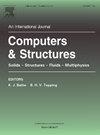Time-domain dynamic analysis of structures equipped with fractional viscoelastic solid and fluid dampers via improved pseudo-force approach
IF 4.8
2区 工程技术
Q1 COMPUTER SCIENCE, INTERDISCIPLINARY APPLICATIONS
引用次数: 0
Abstract
A numerical method for the time-domain dynamic analysis of structures with viscoelastic energy dissipation dampers, modeled using fractional derivatives, is presented. Two fractional viscoelastic models are considered: the fractional Kelvin-Voigt model and another one referred to here as the fractional simplified Maxwell model, to distinguish it from the widely used fractional Maxwell model, where two fractional derivatives appear. In the context of the convolution integral method in state variables, the proposed approach, called the improved pseudo-force method involves: i) discretization of fractional derivatives using the Grünwald-Letnikov approximation; ii) piecewise linear interpolation of both the excitation function and the pseudo-force; iii) evaluation of the response in the modal subspace through recursive relations, using operators computed only at the beginning of the procedure; iv) evaluation of the nodal response by the modal superposition method. The accuracy and stability of the method are demonstrated through applications to a Single-Degree-of-Freedom (SDoF) oscillator and a five-story building equipped with viscoelastic dampers.
基于改进伪力法的分数阶粘弹性固体和流体阻尼器结构时域动力分析
提出了一种采用分数阶导数建模的粘弹性耗能阻尼器结构时域动力分析的数值方法。考虑了两种分数阶粘弹性模型:分数阶Kelvin-Voigt模型和另一种称为分数阶简化Maxwell模型,以区别于广泛使用的分数阶Maxwell模型,其中出现了两个分数阶导数。在状态变量卷积积分方法的背景下,提出的改进伪力方法包括:i)使用gr nwald- letnikov近似对分数阶导数进行离散化;Ii)激励函数和拟力的分段线性插值;Iii)通过递归关系计算模态子空间中的响应,使用仅在程序开始时计算的算子;Iv)用模态叠加法评价节点响应。通过对单自由度(SDoF)振荡器和装有粘弹性阻尼器的五层建筑的应用,验证了该方法的准确性和稳定性。
本文章由计算机程序翻译,如有差异,请以英文原文为准。
求助全文
约1分钟内获得全文
求助全文
来源期刊

Computers & Structures
工程技术-工程:土木
CiteScore
8.80
自引率
6.40%
发文量
122
审稿时长
33 days
期刊介绍:
Computers & Structures publishes advances in the development and use of computational methods for the solution of problems in engineering and the sciences. The range of appropriate contributions is wide, and includes papers on establishing appropriate mathematical models and their numerical solution in all areas of mechanics. The journal also includes articles that present a substantial review of a field in the topics of the journal.
 求助内容:
求助内容: 应助结果提醒方式:
应助结果提醒方式:


